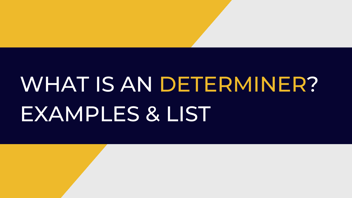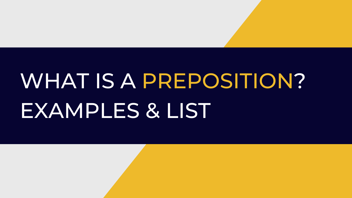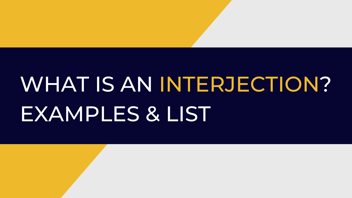What is a Conjunction? Definitions, Examples, and Comprehensive List
If there’s one underused tool that separates average writers from compelling communicators, it’s the humble conjunction.
You’ve seen them—and, but, because, although. Most people treat them like filler. But in the hands of a skilled writer, conjunctions do far more than connect words. They shape rhythm. They clarify logic. They help you write complete sentences that flow and persuade.
As a ghostwriter and writing coach who’s helped over 130 authors turn rough ideas into published books, I’ve found that mastering conjunctions is one of the fastest ways to make your writing stronger, clearer, and more impactful. Whether you're writing academic content, business copy, or your next book, understanding conjunctions—and how they build complex sentences—is a game-changer.
What Is a Conjunction in Grammar?
A conjunction is a part of speech that connects words, phrases, and clauses within a sentence. It’s one of the most essential tools for creating complete sentences that flow logically and read smoothly.
At its core, a conjunction acts like a bridge. It links one idea to another, often showing how those ideas relate—through cause and effect, contrast, condition, or time. Without conjunctions, every sentence would feel abrupt or robotic. With them, you can shape the rhythm of your thoughts, make your writing more persuasive, and build more complex sentences that hold your reader’s attention.
There are three main types of conjunctions in English: coordinating, subordinating, and correlative. Each serves a specific purpose in helping you express ideas with clarity and nuance. Whether you're joining two words or two independent clauses, the right conjunction brings structure and meaning to your writing.
This is not just about grammar. This is about writing that feels alive—writing that moves readers.
Why Every Writer Needs to Master Conjunctions
Most writers treat conjunctions as a given—something you learned back in school and never revisited. But here’s what I tell every client I coach: if you want your writing to flow better, persuade more effectively, and sound more professional, mastering conjunctions is non-negotiable.
Conjunctions work behind the scenes to bring clarity and coherence to your ideas. They guide your reader through cause and effect, contrast, condition, and sequence—often without your reader realizing it. That’s the power of invisible craftsmanship.
Let’s say you’re writing an email, a proposal, or an article. If every sentence stands alone, your message will feel choppy, even amateur. But when you use conjunctions correctly, your thoughts connect naturally, your transitions smooth out, and your arguments build momentum.
In academic writing, conjunctions serve a critical role in building logical arguments. In business writing, they make content more conversational yet professional. And in creative or nonfiction writing, conjunctions shape pacing and rhythm, pulling readers deeper into the narrative.
I’ve helped authors clean up cluttered paragraphs just by tightening their conjunction use. Sometimes, fixing the way two sentences connect is all it takes to make a passage sing. When you understand the conjunction rules and apply them intentionally, you go from writing words to communicating meaning—and that’s what great writing is all about.
The 3 Main Types of Conjunctions (With Examples)
All conjunctions fall into one of three categories: coordinating, subordinating, and correlative. Each type plays a different role in sentence structure and meaning. To write with precision and flow, you need to know not just what these are—but how and when to use them.
Let’s break down each type with examples and guidance for when to apply them in your writing.
Coordinating Conjunctions – Connecting Ideas of Equal Importance
Coordinating conjunctions connect words, phrases, or two independent clauses that are of equal grammatical importance. Think of them as the glue between ideas that deserve the same weight in a sentence.
There are seven coordinating conjunctions—and they’re easy to remember using the FANBOYS mnemonic:
For
And
Nor
But
Or
Yet
So
Here are a few examples in action:
-
I wanted to go for a walk, but it started raining.
-
She writes novels, and she edits professionally.
-
He can stay home, or he can come with us.
Each conjunction here connects two complete thoughts—complete sentences—and gives them equal footing. These are some of the most common coordinating conjunctions used in everyday and professional writing.
As a rule, when a coordinating conjunction connects two independent clauses, you should use a comma before the conjunction. This is one of the simplest yet most overlooked conjunction rules in both business and academic writing.
Subordinating Conjunctions – Creating Logical Relationships
While coordinating conjunctions join equals, subordinating conjunctions connect unequal elements—specifically, a dependent clause to an independent clause. The subordinating conjunction introduces the dependent clause, making it clear how the two ideas relate.
These conjunctions often signal:
-
Cause and effect (because, since, so that)
-
Contrast (although, even though, whereas)
-
Time (after, before, until, when)
-
Condition (if, unless, provided that)
Here’s what it looks like in a sentence:
-
Although she was tired, she kept working on her manuscript.
-
Because the deadline was tight, we canceled our weekend plans.
-
If you want better results, you have to write more intentionally.
In each case, the subordinating conjunction introduces a dependent clause—a group of words that cannot stand alone—and connects it to a full independent clause to form a complete sentence.
Some of the most common subordinating conjunctions include:
-
because
-
although
-
if
-
since
-
unless
-
while
-
after
-
before
Writers often misuse or omit these conjunctions, resulting in sentence fragments or run-ons. Mastering them helps you express complex relationships and makes your writing more polished and persuasive.
Correlative Conjunctions – Pairing Ideas for Emphasis
Correlative conjunctions are unique in that they always work in pairs to join equal grammatical elements—two words, two phrases, or two clauses. Think of them as both/and kinds of connectors.
Here are the most common pairs of correlative conjunctions:
-
either … or
-
neither … nor
-
both … and
-
not only … but also
-
whether … or
-
as … as
Examples:
-
Both the editor and the author agreed to revise the chapter.
-
Either you write with clarity, or you risk losing your reader.
-
He was not only late but also unprepared.
These are powerful tools in persuasive and academic writing, where emphasis and balance matter. Using correlative conjunctions well adds rhythm and symmetry to your sentences—something skilled writers always strive for.
Pro tip: Always ensure that the grammatical structure following each part of the pair matches. For example, if “both” is followed by a noun, “and” should also be followed by a noun—not a verb or clause. This parallelism is key to maintaining clarity and polish.
How Conjunctions Improve Sentence Flow
If you’ve ever read a paragraph that felt dry, robotic, or overly repetitive, chances are it lacked variety in sentence structure—and likely underused conjunctions. One of the simplest ways to improve writing flow is by using conjunctions to combine short, choppy sentences into more complex sentences.
Let’s take a look at two versions of the same paragraph. The first version contains complete sentences, but it feels mechanical. The second version uses conjunctions to create smoother transitions and a more engaging rhythm.
Without Conjunctions:
Léandre had breakfast. Léandre went to the store. He bought a cup of coffee and a newspaper. He looked at the morning sky with wonder. He asked himself what he was going to do that day. It was a Saturday. He had no plans. He was keen on spending the day in a meaningful way in the beautiful city of New York. He had moved to the Big Apple six months prior. However, he still wasn't quite familiar with all the city had to offer. Busy launching his new book and a new business venture, he had not had a lot of free time. However, he longed to get to know the city more intimately.
With Conjunctions:
Before having breakfast, Léandre went to the store, and he bought a cup of coffee and a newspaper. He looked at the morning sky with wonder and asked himself what he was going to do that day. It was a Saturday. He had no plans, but he was keen on spending the day in a meaningful way in the beautiful city of New York. Although he had moved to the Big Apple six months prior, he still wasn't quite familiar with all the city had to offer. Busy launching his new book and a new business venture, he had not had a lot of free time. Yet he longed to get to know the city more intimately.
The second version flows better because it uses a variety of conjunctions—coordinating, subordinating, and even correlative structures—to show how ideas connect. Instead of isolated facts, we see a narrative thread. This is how conjunctions work: they transform a collection of thoughts into something cohesive and compelling.
When you’re writing, think about how your words, phrases, and clauses relate to each other. Use conjunctions to express that relationship. Your readers will notice—and appreciate—the difference.
Rules for Using Conjunctions Effectively
Using conjunctions isn't just about linking words or clauses together. It’s about doing so with clarity and precision. When used correctly, conjunctions improve sentence flow, establish logical relationships, and create stronger, more professional writing. Here are four essential rules every writer should know.
1. Use a comma when joining two independent clauses with a coordinating conjunction
When a coordinating conjunction such as and, but, or so joins two independent clauses—each capable of standing alone as a complete sentence—you must include a comma before the conjunction.
Correct:
She planned to submit the proposal, but the deadline was moved.
Incorrect:
She planned to submit the proposal but the deadline was moved.
This rule helps readers process your sentence structure correctly. It’s especially important in academic writing or formal business communication, where clarity and grammar directly impact your credibility.
2. Don’t place a comma before a subordinating conjunction—unless the dependent clause comes first
Subordinating conjunctions connect a dependent clause to an independent clause. Typically, no comma is needed when the subordinating conjunction falls between the two. However, if the dependent clause comes first, you should use a comma after it.
Correct:
Although the team missed its target, the project was still a success.
The project was still a success although the team missed its target.
Incorrect:
The project was still a success, although the team missed its target.
This distinction is critical when working with subordinating conjunctions like although, because, while, and if. It helps clarify the relationship between ideas and ensures your sentence is grammatically sound.
3. Keep grammatical structure parallel in correlative conjunctions
Correlative conjunctions like either/or, neither/nor, and not only/but also come in pairs. Each element in the pair must be followed by the same grammatical structure—a principle known as parallelism.
Correct:
Not only did she revise the manuscript, but she also met the publishing deadline.
Either you submit the first draft on time or you risk missing the entire publishing window.
Incorrect:
Either you submit the first draft on time or missing the deadline becomes a risk.
Mismatched structures cause confusion and disrupt sentence flow. Maintaining parallelism keeps your writing tight and professional.
4. Avoid overusing conjunctions
Too many conjunctions in a single sentence—or overusing them across multiple sentences—can clutter your writing. Skilled writers use conjunctions purposefully, not as a crutch to patch together long strings of ideas.
Ask yourself: Can this sentence be split for clarity? Can I vary sentence length for better rhythm? Strategic use of conjunctions is about knowing when to link—and when to let a thought stand alone.
Mastering these rules takes your writing from grammatically correct to stylistically sharp. It also ensures your use of conjunctions supports your message rather than distracting from it.
Master List of Conjunctions (100+ Examples)
For writers who want a quick-reference resource—or anyone looking to expand their vocabulary—here’s a categorized list of over 100 conjunctions. Use this as a guide when crafting more fluid, expressive, and varied sentences.
Coordinating Conjunctions
These join words, phrases, or independent clauses of equal importance. There are only seven, but they’re used constantly in writing.
-
For
-
And
-
Nor
-
But
-
Or
-
Yet
-
So
These are often remembered by the FANBOYS mnemonic, which we’ll expand on in the next section.
Subordinating Conjunctions
These introduce dependent clauses and establish relationships like time, cause, condition, or contrast. They’re essential for writing complex and compound-complex sentences.
-
after
-
although
-
as
-
as if
-
as long as
-
as much as
-
as soon as
-
as though
-
assuming that
-
because
-
before
-
by the time
-
even
-
even if
-
even though
-
how
-
if
-
if only
-
in case that
-
in order that
-
inasmuch
-
just as
-
lest
-
now that
-
once
-
only if
-
provided that
-
rather than
-
since
-
so that
-
supposing
-
than
-
that
-
though
-
till
-
unless
-
until
-
whatever
-
when
-
whenever
-
where
-
whereas
-
wherever
-
whether
-
which
-
while
-
who
-
whoever
-
whomever
-
whose
-
why
These common subordinating conjunctions are used frequently in both academic and professional writing to express relationships between clauses and create complete sentences with layered meaning.
Correlative Conjunctions
These work in pairs to connect two equal grammatical elements, and they’re particularly useful for emphasizing contrast or choice.
-
as … as
-
both … and
-
either … or
-
neither … nor
-
not only … but also
-
such … that
-
rather … than
-
no sooner … than
-
if … then
-
scarcely … when
-
whether … or
Each pair demands careful attention to structure and parallelism, especially in formal writing. When used correctly, they help balance tone and reinforce clarity.
As a writing coach, I encourage every client to keep a list like this nearby—especially when revising for flow or preparing material for publication. The difference between flat and polished writing often comes down to the intentional use of devices like these.
Teaching Conjunctions: A Mnemonic Device for Retention
For those learning conjunctions—or those teaching them—mnemonic devices are a helpful way to lock in both function and form.
The most popular is FANBOYS, used to remember the seven coordinating conjunctions:
-
For
-
And
-
Nor
-
But
-
Or
-
Yet
-
So
This tool is taught in schools and still used by editors and professional writers because it works. It’s short, it’s easy to remember, and it reinforces one of the most useful tools in sentence construction.
For subordinating conjunctions, a lesser-known but equally useful mnemonic is AAAWWUBBIS:
-
After
-
Although
-
As
-
When
-
While
-
Until
-
Because
-
Before
-
If
-
Since
This helps identify common subordinating conjunctions that often introduce dependent clauses. It's especially useful when revising writing for structure or teaching how to form complex sentences.
These devices may sound elementary, but even experienced writers benefit from them—especially when facing tight deadlines, editing under pressure, or coaching others through revisions. When you have frameworks like these embedded in memory, your writing becomes faster, more confident, and more precise.
Conjunctions in Academic and Professional Writing
Whether you're crafting an academic paper, a business proposal, or a thought leadership article, conjunctions play a critical role in shaping your message. They don’t just hold sentences together—they signal logic, hierarchy, and intention.
In academic writing, conjunctions are essential for building structured arguments and clarifying relationships between ideas. A well-placed although, therefore, or because can communicate cause and effect or contrast in a way that elevates your analysis.
For example:
Although the study showed promising results, the researchers cautioned against overgeneralizing.
Because the methodology was consistent, the findings gained credibility.
These conjunctions help express nuanced relationships between main clauses and supporting information, keeping your argument logically sound and readable.
In professional writing, the function is no different. Whether you’re writing an internal report, client email, or product copy, your ability to connect words, phrases, and clauses clearly impacts how your message is received. Using conjunctions strategically can make your tone more diplomatic, your transitions smoother, and your ideas more persuasive.
For business writers especially, conjunctions prevent your writing from sounding robotic or fragmented. They allow you to vary sentence length, shift tone, and guide readers through multiple levels of meaning—all while maintaining a professional voice.
The most persuasive writing isn’t always the flashiest. It’s the clearest. And conjunctions are central to that clarity.
Want to Be a More Persuasive Writer? Start Here
Here’s the truth: writing isn't just about grammar or structure. It's about influence. And one of the fastest ways to increase your influence through writing is to master the small, often-overlooked tools—like conjunctions.
These are the links that hold your ideas together. They determine whether your thoughts come across as fragmented or fluid, as shallow or sophisticated. When used intentionally, they help you write sentences that not only connect words but build momentum, logic, and persuasion.
If you’ve made it this far, you're clearly serious about improving your writing. That’s a good sign. Because the writers who grow the fastest are the ones who care about the smallest details.
Whether you're revising your first book, improving internal documents, or preparing for a TED-style keynote, refining your use of conjunctions can make your writing tighter, clearer, and more impactful.
Looking to take your writing to the next level? This is exactly what I help my clients do—whether they’re ghostwriting their first book or refining thought leadership content.
Need help making your writing more persuasive, polished, and professional?
Let’s talk.
-png.png)





